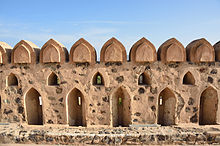Oman adopted Islam in the 7th century, during the lifetime of the prophet Muhammad. Ibadismbecame the dominant religious sect in Oman by the 8th century; Oman is currently the only country in the Islamic world with a majority Ibadi population. Ibadhism is known for its "moderate conservatism". One distinguishing feature of Ibadism is the choice of ruler by communal consensus and consent.
The relatively recent name of "Muscat and Oman" (which was abolished in 1970 in favor of "Sultanate of Oman"), implies two historically irreconcilable political cultures: the coastal tradition, the more cosmopolitan, secular, Muscat tradition of the coast ruled by the sultan; and the interior tradition of insularity, tribal in origin and ruled by an imam according to the ideological tenets of Ibadism. The more cosmopolitan has been the ascending political culture since the founding of theAl Said dynasty in 1744, although the imamate tradition has found intermittent expression.
Several millennia ago, Arab tribes migrated eastward to Oman, coinciding with the increasing presence in the region of peoples from present-day Iran. In the 6th century, Arabs succeeded in repelling encroachments of these ethnic groups; the conversion of Arab tribes to Islam in the 7th century resulted in the displacement of the settlers from Iran. The introduction of Ibadism vested power in the imam, the leader nominated by the ulema. The imam's position was confirmed when the imam—having gained the allegiance of the tribal sheiks—received the bay'ah (oath of allegiance) from the public.[citation needed]
In 751 Ibadi Muslims, a moderate branch of the Kharijites, established an imamate in Oman. Despite interruptions, the Ibadi imamate survived until the mid-20th century.
But Oman was nonetheless conquered by several foreign powers, having been controlled by the Qarmatians between 931–932 and then again between 933–934. Between 967 and 1053, Oman was part of the domain of the Iranian Buyyids, and between 1053 and 1154, Oman was part of the Great Seljuq Empire.
In 1154, the indigenous Nabhani dynasty took control of Oman, and the Nabhani kings ruled Oman until 1470, with an interruption of 37 years between 1406 and 1443.
Muscat was taken by the Portuguese on 1 April 1515, and was held until 26 January 1650, although the Ottomans controlled Muscat between 1550–1551 and 1581–1588. In about the year 1600, Nabhani rule was temporarily restored to Oman, although that lasted only to 1624, when fifth imamate, which is also known as the Yarubid Imamate. The latter recaptured Muscat from the Portuguese in 1650 after a colonial presence on the northeastern coast of Oman dating to 1508. The Yarubid dynasty expanded, acquiring former Portuguese colonies in East Africa and engaging in the slave trade. By 1719 dynastic succession led to the nomination of Saif ibn Sultan II. His candidacy prompted a rivalry among the ulama and a civil war between the two major tribes, the Hinawi and the Ghafiri, with the Ghafiri supporting Saif ibn Sultan II. He assumed power in 1748 after the leaders of both factions had been killed in battle, but the rivalry continued, with the factionalization working in favor of the Iranians, who occupied Muscat and Sohar in 1743.
The Iranians had occupied the coast before—indeed the coast was often the possession of various empires. These empires brought order to the religious and ethnic diversity of the population of this cosmopolitan region. Yet the intervention on behalf of an unpopular dynasty brought about a revolt. The leader of the revolt, Ahmad ibn Said al Said, was elected sultan of Muscat upon the expulsion of the Persians. The position of Sultan of Muscat would remain in the possession of the Al Said clan even when the imamate of Oman remained out of reach.[citation needed]
The Al Said clan became a royal dynasty when Ahmad ibn Said Al Said was elected imam following the expulsion of the Iranians from Muscat in 1744. Like its predecessors, Al Said dynastic rule has been characterized by a history of internecine family struggle, fratricide, and usurpation. Apart from threats within the ruling family, there was the omnipresent challenge from the independent tribes of the interior who rejected the authority of the sultan, recognizing the imam as the sole legitimate leader and pressing, by resort to arms, for the restoration of the imamate.
Schisms within the ruling family were apparent before Ahmad ibn Said's death in 1783 and were later manifest with the division of the family into two main lines, the Sultan ibn Ahmad Al Said (r. 1792–1806) line controlling the maritime state, with nominal control over the entire country; and the Qais branch, with authority over the Al Batinah and Ar Rustaq areas. During the period of Sultan Said ibn Sultan Al Said's rule (1806–1856), Oman cultivated its East African colonies, profiting from the slave trade. As a regional commercial power in the 19th century, Oman held territories on the island of Zanzibar off the coast of East Africa, the area along the coast of East Africa known as Zanj including Mombasa and Dar es Salaam, and until 1958 in Gwadar (in present-day Pakistan) on the coast of the Arabian Sea. But when the British declared slavery illegal in the mid-19th century, the sultanate's fortunes reversed. The economy collapsed, and many Omani families migrated to Zanzibar. The population of Muscat fell from 55,000 to 8,000 between the 1850s and 1870s Most of the overseas possessions were seized by the United Kingdom and by 1850 Oman was an isolated and poor area of the world.


